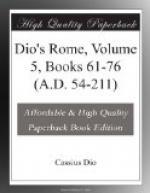Meanwhile Longinus, having [through his freedman] secured a poison [—he had promised Decebalus that he would reconcile Trajan to the proposition, in order that the Dacian should be as far as possible from suspecting what was to happen, and so not keep an especially careful watch over him. Also, to enable his servant to attain safety, he wrote a letter containing a supplication, and gave it to the freedman to carry to Trajan. Then, when he had gone, at night he took the poison,] drank it and died. [After this event Decebalus asked Trajan to give him back his freedman, promising to give him in return the body of Longinus and ten captives. He sent at once the centurion who had been captured with the dead general, assuming that this man would arrange the matter for him; and it was from the centurion that the whole story of Longinus was learned. However, Trajan neither sent him back, nor surrendered the freedman, deeming his safety more valuable for establishing the dignity of the empire than the of Longinus.]
[Sidenote:—13—] Now, Trajan constructed over the Ister a stone bridge, for which I cannot sufficiently admire him. His other works are most brilliant, but this surpasses them. There are twenty square pieces of stone, the height of which is one hundred and fifty feet above the foundations and the breadth sixty, and these, standing at a distance of one hundred and seventy feet from one to another, are connected by arches. How then could one fail to be astonished at the expenditure made upon them? Or the manner in which each of them was placed in a river so deep, in water so full of eddies, on ground so slimy? It was impossible, you note, to divert the course of the river in any direction. I have spoken of the breadth of the river; but the stream is not uniformly so limited, since it covers in some places twice and elsewhere thrice as much ground, but the narrowest point, and the one in that region most adapted to bridge-building, has just those dimensions. Yet the very fact that the river here shrinks from a great flood to such a narrow channel and is here confined, though it again expands into a greater flood, makes it all the more violent and deep; and this feature must be considered in estimating the difficulty of preparing a bridge. This achievement, then, shows the greatness of Trajan’s designs, though the bridge is of no particular use to us. Merely the piers are standing, affording no means of crossing, as if they were erected for the sole purpose of demonstrating




